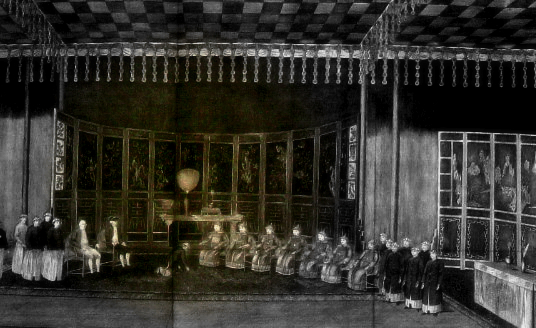
Nihon Ōdai Ichiran: A Chronicle of Japanese Rule
During the Sakoku years of Japan, the country was deeply isolated from the rest of the world except for a few foreigners, mostly Koreans and Chinese. The only Western trade with Japan was from the Dutch East India Company. Japan’s self-imposed isolation made their wares much coveted by foreigners.
Isaac Titsingh (1745–1812) was a Dutch merchant-trader, surgeon, scholar, and ambassador. He was a senior official of the Dutch East India Company with a long career in East Asia. Titsingh represented the European trading company exclusively as an official contact in Tokugawa, Japan. He had the opportunity to travel to Edo and meet with high ranking bakufu officials. When he returned to Europe in 1797, Titsingh brought the very first Japanese-authored historical account published and circulated for scholarly study in the West, known as Nihon Ōdai Ichiran.
 Illustration depicting the last European delegation to be received at the Qianlong Court in 1795 — Isaac Titsingh (seated European with hat, far left) and A.E. van Braam Houckgeest (seated European without hat). This nearly-contemporaneous artwork had been specifically commissioned by van Braam for inclusion in his 1798 book describing the travels and triumphs of the Titsingh mission to “Pekin” a scant three years earlier.
Illustration depicting the last European delegation to be received at the Qianlong Court in 1795 — Isaac Titsingh (seated European with hat, far left) and A.E. van Braam Houckgeest (seated European without hat). This nearly-contemporaneous artwork had been specifically commissioned by van Braam for inclusion in his 1798 book describing the travels and triumphs of the Titsingh mission to “Pekin” a scant three years earlier.
Nihon Ōdai Ichiran (日本王代一覧 ), “The Table of the Rulers of Japan,” is a narrative from the perspective of the Japanese author and his samurai patron, the daimyo of the Obama domain of Wakasa Province, tairō (great elder) Sakai Tadakatsu. Nihon Ōdai Ichiran is a chronicle of 17th-century Japanese emperors and their reigns, with entries on some noteworthy events in Japanese history. The compilation of written works was almost complete in 1783 when Isaac Titsingh sent a manuscript to the daimyo of Tamba, Kutsuki Masatsuna. When Masatsuna finished editing the manuscript, he sent it back to Titsingh, who had become head of the Dutch East Indies Company trade operations in Hoogly, West Bengal. But in 1785, Masatsuna’s comments were lost in a shipwreck en route from Japan to India. In 1812, Isaac Titsingh’s drafted a final version of the book, which he dedicated to his friend Kutsuki Masatsuna.
 Nihon Ōdai Ichiran, an extensive seven volumes, was later translated into French as Nipon o daï itsi ran. The seven volumes were presumed lost during the Napoleonic Wars. After Isaac Titsingh’s death in 1812, the manuscript sat in near neglect. Later, the project was revived, and the Oriental Translation Fund of Great Britain and Ireland published the work; publication and printing took place in Paris, with London handling the distribution. At last the Western world could begin to clear away the mystery of Japan.
Nihon Ōdai Ichiran, an extensive seven volumes, was later translated into French as Nipon o daï itsi ran. The seven volumes were presumed lost during the Napoleonic Wars. After Isaac Titsingh’s death in 1812, the manuscript sat in near neglect. Later, the project was revived, and the Oriental Translation Fund of Great Britain and Ireland published the work; publication and printing took place in Paris, with London handling the distribution. At last the Western world could begin to clear away the mystery of Japan.
Title page of French translation of Nihon Ōdai Ichiran.
